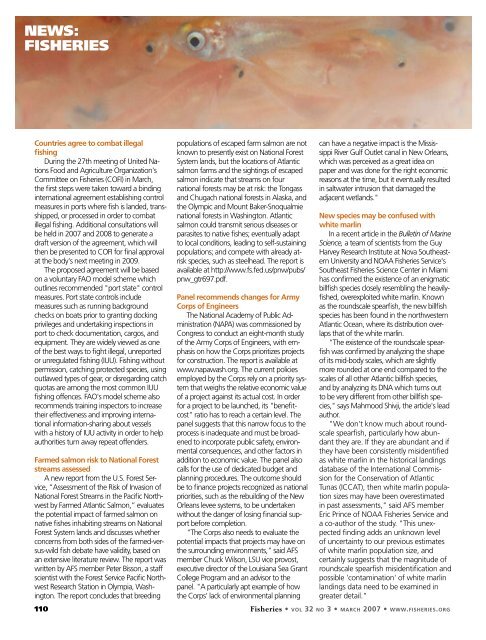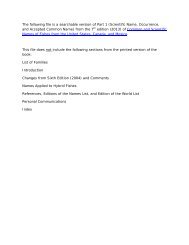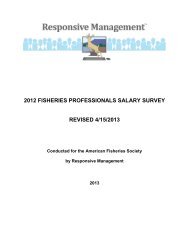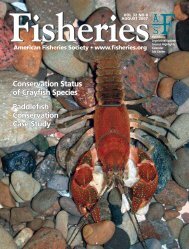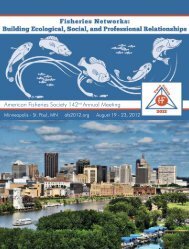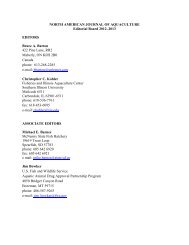Fisheries Volume 32 No. 3 - American Fisheries Society
Fisheries Volume 32 No. 3 - American Fisheries Society
Fisheries Volume 32 No. 3 - American Fisheries Society
You also want an ePaper? Increase the reach of your titles
YUMPU automatically turns print PDFs into web optimized ePapers that Google loves.
neWS:<br />
FISHerIeS<br />
Countries agree to combat illegal<br />
fishing<br />
During the 27th meeting of United Nations<br />
Food and Agriculture Organization's<br />
Committee on <strong>Fisheries</strong> (COFI) in March,<br />
the first steps were taken toward a binding<br />
international agreement establishing control<br />
measures in ports where fish is landed, transshipped,<br />
or processed in order to combat<br />
illegal fishing. Additional consultations will<br />
be held in 2007 and 2008 to generate a<br />
draft version of the agreement, which will<br />
then be presented to COFI for final approval<br />
at the body's next meeting in 2009.<br />
The proposed agreement will be based<br />
on a voluntary FAO model scheme which<br />
outlines recommended "port state" control<br />
measures. Port state controls include<br />
measures such as running background<br />
checks on boats prior to granting docking<br />
privileges and undertaking inspections in<br />
port to check documentation, cargos, and<br />
equipment. They are widely viewed as one<br />
of the best ways to fight illegal, unreported<br />
or unregulated fishing (IUU). Fishing without<br />
permission, catching protected species, using<br />
outlawed types of gear, or disregarding catch<br />
quotas are among the most common IUU<br />
fishing offences. FAO's model scheme also<br />
recommends training inspectors to increase<br />
their effectiveness and improving international<br />
information-sharing about vessels<br />
with a history of IUU activity in order to help<br />
authorities turn away repeat offenders.<br />
Farmed salmon risk to National Forest<br />
streams assessed<br />
A new report from the U.S. Forest Service,<br />
“Assessment of the Risk of Invasion of<br />
National Forest Streams in the Pacific <strong>No</strong>rthwest<br />
by Farmed Atlantic Salmon,” evaluates<br />
the potential impact of farmed salmon on<br />
native fishes inhabiting streams on National<br />
Forest System lands and discusses whether<br />
concerns from both sides of the farmed-versus-wild<br />
fish debate have validity, based on<br />
an extensive literature review. The report was<br />
written by AFS member Peter Bisson, a staff<br />
scientist with the Forest Service Pacific <strong>No</strong>rthwest<br />
Research Station in Olympia, Washington.<br />
The report concludes that breeding<br />
populations of escaped farm salmon are not<br />
known to presently exist on National Forest<br />
System lands, but the locations of Atlantic<br />
salmon farms and the sightings of escaped<br />
salmon indicate that streams on four<br />
national forests may be at risk: the Tongass<br />
and Chugach national forests in Alaska, and<br />
the Olympic and Mount Baker-Snoqualmie<br />
national forests in Washington. Atlantic<br />
salmon could transmit serious diseases or<br />
parasites to native fishes; eventually adapt<br />
to local conditions, leading to self-sustaining<br />
populations; and compete with already atrisk<br />
species, such as steelhead. The report is<br />
available at http://www.fs.fed.us/pnw/pubs/<br />
pnw_gtr697.pdf.<br />
Panel recommends changes for Army<br />
Corps of Engineers<br />
The National Academy of Public Administration<br />
(NAPA) was commissioned by<br />
Congress to conduct an eight-month study<br />
of the Army Corps of Engineers, with emphasis<br />
on how the Corps prioritizes projects<br />
for construction. The report is available at<br />
www.napawash.org. The current policies<br />
employed by the Corps rely on a priority system<br />
that weighs the relative economic value<br />
of a project against its actual cost. In order<br />
for a project to be launched, its "benefitcost"<br />
ratio has to reach a certain level. The<br />
panel suggests that this narrow focus to the<br />
process is inadequate and must be broadened<br />
to incorporate public safety, environmental<br />
consequences, and other factors in<br />
addition to economic value. The panel also<br />
calls for the use of dedicated budget and<br />
planning procedures. The outcome should<br />
be to finance projects recognized as national<br />
priorities, such as the rebuilding of the New<br />
Orleans levee systems, to be undertaken<br />
without the danger of losing financial support<br />
before completion.<br />
"The Corps also needs to evaluate the<br />
potential impacts that projects may have on<br />
the surrounding environments," said AFS<br />
member Chuck Wilson, LSU vice provost,<br />
executive director of the Louisiana Sea Grant<br />
College Program and an advisor to the<br />
panel. "A particularly apt example of how<br />
the Corps’ lack of environmental planning<br />
can have a negative impact is the Mississippi<br />
River Gulf Outlet canal in New Orleans,<br />
which was perceived as a great idea on<br />
paper and was done for the right economic<br />
reasons at the time, but it eventually resulted<br />
in saltwater intrusion that damaged the<br />
adjacent wetlands."<br />
New species may be confused with<br />
white marlin<br />
In a recent article in the Bulletin of Marine<br />
Science, a team of scientists from the Guy<br />
Harvey Research Institute at <strong>No</strong>va Southeastern<br />
University and NOAA <strong>Fisheries</strong> Service's<br />
Southeast <strong>Fisheries</strong> Science Center in Miami<br />
has confirmed the existence of an enigmatic<br />
billfish species closely resembling the heavilyfished,<br />
overexploited white marlin. Known<br />
as the roundscale spearfish, the new billfish<br />
species has been found in the northwestern<br />
Atlantic Ocean, where its distribution overlaps<br />
that of the white marlin.<br />
“The existence of the roundscale spearfish<br />
was confirmed by analyzing the shape<br />
of its mid-body scales, which are slightly<br />
more rounded at one end compared to the<br />
scales of all other Atlantic billfish species,<br />
and by analyzing its DNA which turns out<br />
to be very different from other billfish species,"<br />
says Mahmood Shivji, the article's lead<br />
author.<br />
"We don't know much about roundscale<br />
spearfish, particularly how abundant<br />
they are. If they are abundant and if<br />
they have been consistently misidentified<br />
as white marlin in the historical landings<br />
database of the International Commission<br />
for the Conservation of Atlantic<br />
Tunas (ICCAT), then white marlin population<br />
sizes may have been overestimated<br />
in past assessments," said AFS member<br />
Eric Prince of NOAA <strong>Fisheries</strong> Service and<br />
a co-author of the study. "This unexpected<br />
finding adds an unknown level<br />
of uncertainty to our previous estimates<br />
of white marlin population size, and<br />
certainly suggests that the magnitude of<br />
roundscale spearfish misidentification and<br />
possible 'contamination' of white marlin<br />
landings data need to be examined in<br />
greater detail."<br />
110 <strong>Fisheries</strong> • vol <strong>32</strong> no 3 • march 2007 • www.fisheries.org


